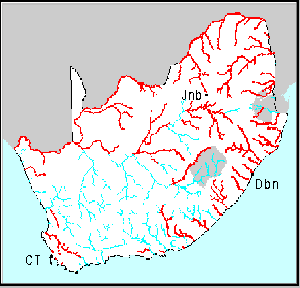



NMMP NEWS | |
| Home Page of the National Microbiological Water Quality Monitoring Programme | October 1997 |
THE NATIONAL MICROBIOLOGICAL
WATER QUALITY MONITORING
PROGRAMME
-- PILOT SCALE PROJECT
Fanus Venter, Carin van Ginkel, Martella du Preez
INTRODUCTION
The NMMP project team is currently conducting Phase 2: Testing of Design by means of two separate but interlinked studies. The first study is concerned with the selection and prioritization of areas to be monitored. The second study addresses various aspects of the actual monitoring programme such as data collection, storage, analysis and reporting.
The project team will use the results of these studies to fine-tune their procedures before embarking on a full scale implementation.
AREA SELECTION STUDY
Microbial constituents demonstrate non-conservative behaviour and national microbiological monitoring cannot follow the same approach used for conservative constituents. The monitoring programme will thus concentrate on areas where the microbiological water quality of surface water is likely to be severely impacted and where it poses a major risk to the health of many water users in the area. The focus of the area selection study is therefore to identify and prioritize these high risk areas in South Africa.
For the first half of 1997 the focus of the area selection process was to screen the country and identify impacted tertiary catchments. Based on their own experience and that of water quality specialists in the field, the project team selected catchments where faecal pollution of surface water may pose a serious risk to human health. With the help of the various regional offices of DWAF the following map was produced. Heavy red lines represent the rivers where faecal pollution may be a problem.
 The next phase of this study will be to collect
land cover and water use information for the
selection and prioritization of high risk areas.
For the testing of the prioritization process, the
team will study nine catchments representing
various parts of the country in detail. We will
evaluate the prioritization process and examine
all the selected catchments shown on the map, in
order to compile a priority list of high risk areas
to be monitored as part of the national
programme.
The next phase of this study will be to collect
land cover and water use information for the
selection and prioritization of high risk areas.
For the testing of the prioritization process, the
team will study nine catchments representing
various parts of the country in detail. We will
evaluate the prioritization process and examine
all the selected catchments shown on the map, in
order to compile a priority list of high risk areas
to be monitored as part of the national
programme.
MONITORING STUDY
The second study focuses on implementing a monitoring programme on a pilot scale in order to test the protocols and approaches described in the conceptual design for the national monitoring programme.
Sample collection and analysis has commenced at nine sampling sites. We selected three sampling sites to ensure representation of all the water uses and environmental aspects which may influence microbial water quality. One site is in an urban area (Klip River, Gauteng -- near Johannesburg -- "Jnb" on map) and six sampling sites are in rural areas (Mpolweni, KwaZulu-Natal, north of Durban -- "Dbn" on map).
We selected sites that DWAF or water boards already monitor according to four sensitive water uses:
VARIABLES MONITORED
We selected faecal coliforms, widely used as indicators of the potential health risk to water users, as the single microbiological variable to be monitored in the programme. Faecal coliforms are enumerated using the membrane filtration method and the MPN method for very turbid samples.
Physical and chemical variables provide information on environmental conditions affecting the survival of microorganisms. Included in this programme are pH, temperature and turbidity
SAMPLING FREQUENCY
Statistical analysis of existing microbiological data of surface water showed that weekly sampling would be sufficient. To observe fluctuations occurring during the rainy season, we will increase the sampling frequency during the rainy season for a period of one month.
DATA COLLECTION AND STORAGE
The project team has designed data collection sheets for the capture of site information, analysis methods and results. Operation and management of monitoring will occur on the Water Quality Information Management System (WQIMS) at IWQS. The DWAF Hydrological Information System - Quality Databank (HIS-QualDB) will store all sample data.
DATA ANALYSIS
We will evaluate our microbiological data against the potential health risk for each of the four water uses on the basis of proposed risk categories and reports issued.